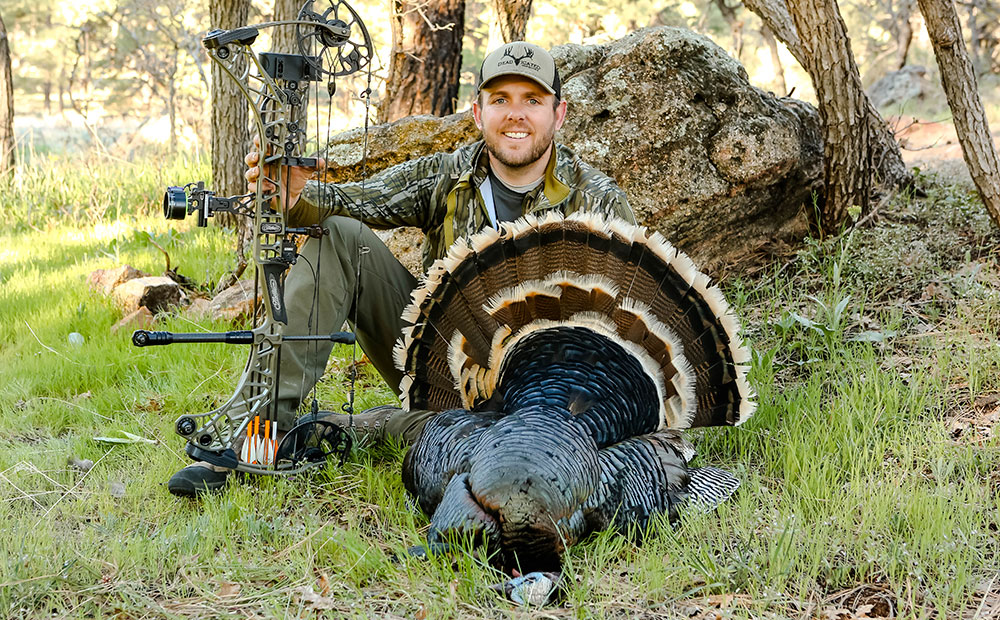
Discerning turkey hunters have ample opportunities to hunt the frosty, white-tipped Merriam’s that call the vast expanses of the Rocky Mountains home, if they know where to look. But due to the varying and often rugged terrain that Merriam’s inhabit, successfully hunting them requires slightly different tactics than would be utilized on their close relatives found in other parts of the country. In fact, hunting Merriam’s turkeys is a lot like hunting Western big game, and an outing, successful or not, offers hunters the opportunity to hone both sets of skills.

Many turkey hunting tactics apply no matter the part of the country or subspecies that you are hunting—but not all. Below are five tips aimed specifically at pursuing the striking mountain Merriam’s of the West.
Hunt for Big Game
The Merriam’s subspecies, one of five subspecies of wild turkey in the U.S., can be found in most Western states from as far north as South Dakota, down into Arizona and New Mexico. Begin your quest by focusing on states and areas in which you already have an interest in big-game hunting; that way you can get double the benefit out of any research and time afield. Once you’ve got a place picked out, visit the proper fish-and-game websites and search out season dates, available units and tags (where appropriate), and even past years’ success rates.
While a mounted turkey fan may not make as bold a statement as an elk rack would in your den, the effort you put into planning and preparing for a Merriam’s hunt can directly correlate to your future success. Don’t be afraid to make a call to the local biologist or game warden and pick their brain about opportunities that are available in their region. You can’t expect them to give you a secret spot, but most will be more than willing to provide you with a good idea of bird numbers, public land opportunities and the success hunters typically experience.
Scout Online
Never underestimate the benefits of scouting from home via your cell phone or computer; I now consider it a necessity for any upcoming hunt, regardless of the game I’m after. With an area picked out for Merriam’s, whether it’s an entire game unit or a private-land plot, scour over the land from above via an Internet mapping service like Google Earth. You’re looking for three key geographical features. First, look for creek bottoms that appear to have large cottonwood-type trees. Not only do these places provide water to drink, but the cottonwoods offer a safe place to roost nearby. Next, you’ll want to look for clearings or openings near these creek-bottom roost trees. Unlike in other parts of the country, mountain Merriam’s typically do not have an agriculture field to fly down into, and instead will look for a natural strutting zone. Any place that offers a wide field of view, where a gobbler can call and be seen by the hens, should be of note. Lastly, you’ll want to look for areas that combine these features with the magic of being as far away from access roads as you can manage. On private land it may not be an issue, but you can always count on dealing with outside pressure when hunting public land. Getting away from roads will increase your likelihood of being the only one hunting a particular flock of birds.
Spend Time Behind Glass
As with any Western big-game hunting, a quality binocular and spotting scope can be a tremendous asset when locating Merriam’s turkeys. Find a good vantage point and get there early to listen for toms sounding off from their roost trees. Once the sun rises, meticulously glass for turkeys flying off the roost, strutting in clearings or moving through transitional areas. If you are scouting before the mating season has begun, just remember that wherever hens are found, the toms will surely follow.

Like deer and elk, turkeys—no matter their subspecies—are creatures of habit. When possible, watch birds from a distance for a few days or more to study their daily habits and routines. If left undisturbed, these birds will return to the same roost tree, strut in the same clearings, and use the same paths every day to and from their food sources. This information will be invaluable when attempting to outsmart a wary, open-country tom.
Adapt Your Tactics
Everyone dreams of a fired-up longbeard strutting and drumming his way to the decoy, sticking his neck high at mere steps, but despite what you’ve seen or heard—or how much you take from the tips above—that is always easier said than done. With so many variables out of our control—weather, birds, predators, other hunters—we must be willing to adapt to our surroundings and utilize different tactics when appropriate.
Spot-and-stalk turkey hunting may not be the traditional way of doing things, but just like in mule deer hunting, the ability to get up and move can be a very successful tactic when hunting turkeys out West.
Just like you would on a herd of elk, if birds are henned up or being unresponsive, use the topography to your advantage and close the distance. While the wind and scent won’t be a factor, it goes without saying that turkeys have superhuman eyesight, and sneaking within a shotgun’s effective range on a flock of turkeys will test your spot-and-stalk skills, providing valuable insight that will make you a better deer and elk hunter come fall.
Of course, if you’ve done your homework and studied a particular flock’s habits, you should be able to make a move and position yourself for an ambush along their daily path, increasing the likelihood of an unsuspecting tom strolling right into your lap.
Be Patient
An immense amount of patience may be the single biggest contributing factor to being successful when hunting the West, no matter the species you’re after. Be patient with yourself, the birds and those around you, and the opportunities will follow. Always be a stalwart student of the pursuit and remain open to trying new tactics. Pure Merriam’s turkeys are not around every tree, nor can they be found in every drainage. But with a little grit and a lot of patience, you can have a full Western hunting experience pursuing these incredible mountain birds.




































